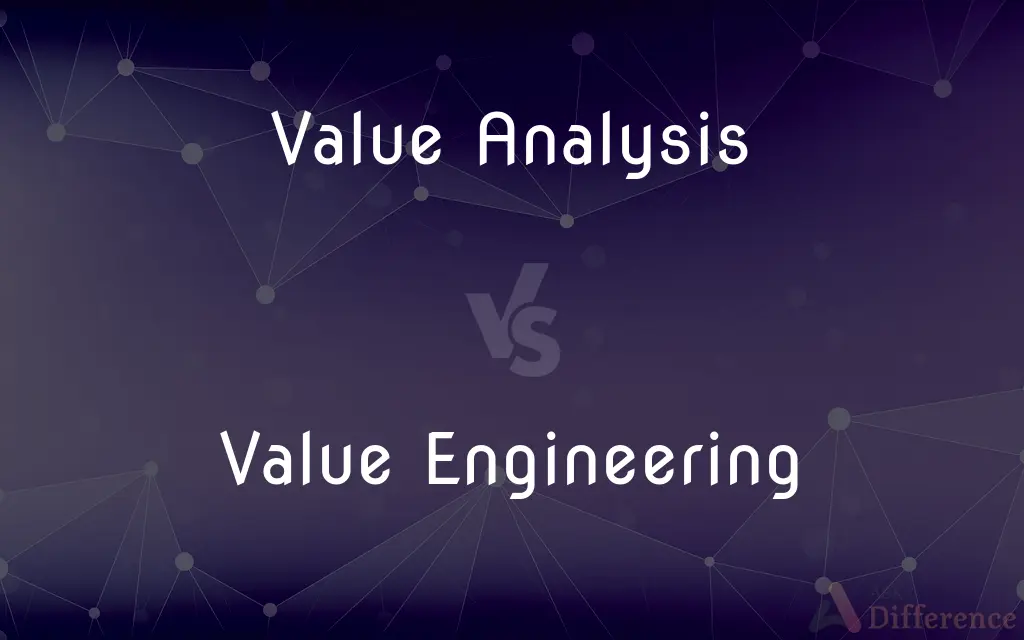Value Analysis vs. Value Engineering — What's the Difference?
By Tayyaba Rehman — Published on December 1, 2023
Value Analysis evaluates products post-production for cost reductions, while Value Engineering focuses on product design to enhance function at lower costs.

Difference Between Value Analysis and Value Engineering
Table of Contents
ADVERTISEMENT
Key Differences
Value Analysis and Value Engineering are both systematic approaches to optimize the value of products, services, or systems. Value Analysis is typically employed once a product has been developed, aiming to find improvements without compromising its function. Its goal is to eliminate unnecessary costs that do not add value to the product or service. On the other hand, Value Engineering is implemented during the design or conceptual phase, before production begins. It ensures that the product or system is designed with maximum value from the outset, often leading to innovative solutions.
Value Analysis emphasizes identifying redundancies or excessive costs in existing products or systems. It questions the rationale behind every element, determining whether it is essential or can be replaced with a more cost-effective alternative. Conversely, Value Engineering, while also concerned with cost-effectiveness, places a more considerable emphasis on improving functionality and overall product performance. It proactively seeks to design the best possible product or system within a given budget or resource constraint.
In a way, Value Analysis can be seen as a corrective measure. Once a product or system is in place, teams assess it to ensure it delivers the best value for its cost. They might adjust components, materials, or processes to make it more efficient. On the flip side, Value Engineering is a preventative measure. By examining potential designs and systems, engineers aim to build something that is inherently cost-effective and functional. The intent is to avoid potential inefficiencies or overruns from the very beginning.
In essence, both Value Analysis and Value Engineering share a common goal: to maximize value by either improving function or reducing cost. However, their timing and methods of approach differ significantly. While Value Analysis looks backward, assessing what has already been created, Value Engineering looks forward, anticipating and designing for optimal value.
Comparison Chart
Phase of Application
Post-production
Design or conceptual phase
ADVERTISEMENT
Primary Focus
Eliminate unnecessary costs
Improve functionality & reduce costs
Nature
Corrective
Preventative
Target
Existing products or systems
Potential designs or systems
Objective
Enhance value by modifications
Design with optimal value from outset
Compare with Definitions
Value Analysis
A systematic process of reviewing product attributes and components to improve its value.
Through Value Analysis, the company identified cheaper materials that maintained the product's durability.
Value Engineering
A systematic procedure during the conceptual phase to innovate and ensure cost-effectiveness.
Before manufacturing the new line of appliances, Value Engineering helped the company decide on the best materials and processes.
Value Analysis
The evaluation of a product's function in relation to its cost.
Value Analysis helped the firm prioritize features based on user needs and affordability.
Value Engineering
A method to improve a product's function while minimizing its cost during the design phase.
Value Engineering was used to design a more efficient and affordable engine for the upcoming car model.
Value Analysis
An assessment tool to optimize the cost-effectiveness of a product after its development.
Post-launch, the tech device underwent Value Analysis to find potential areas of savings.
Value Engineering
An approach to enhance product value by focusing on its functionality and performance relative to its cost.
Through Value Engineering, the architecture firm developed a building design that maximized space utilization without increasing expenses.
Value Analysis
A post-production examination to ensure maximum ROI on a product or system.
Value Analysis was integral in determining the profitability of the new software tool.
Value Engineering
An anticipatory measure in the design process to avoid inefficiencies and overruns.
The bridge project utilized Value Engineering to ensure a balance between structural integrity and budget constraints.
Value Analysis
A technique for identifying and eliminating unnecessary costs in a product or service without compromising its quality or performance.
The team used Value Analysis to reduce the manufacturing cost of the gadget without altering its main features.
Value Engineering
A pre-production strategy to ensure a product or system is developed with optimal value from the outset.
The development of the new software suite heavily relied on Value Engineering to guarantee both functionality and affordability.
Common Curiosities
Is Value Engineering more focused on cost or function?
Value Engineering aims to improve a product's function while also reducing its cost.
Can Value Analysis lead to changes in a product's design?
Yes, Value Analysis can suggest modifications to improve cost-effectiveness without compromising the product's function.
What's the primary difference between Value Analysis and Value Engineering?
Value Analysis is used post-production to eliminate unnecessary costs, while Value Engineering is used during the design phase to enhance function at a reduced cost.
Can both Value Analysis and Value Engineering be applied to the same product?
Yes, a product can first be designed using Value Engineering and later undergo Value Analysis for further refinements.
When is Value Analysis typically implemented?
Value Analysis is typically applied after a product has been developed.
Is Value Analysis always done after Value Engineering?
Not necessarily. While Value Engineering is done during the design phase, Value Analysis can be applied even if Value Engineering wasn't initially used.
Can Value Engineering result in a product redesign?
Yes, Value Engineering can lead to alternative designs that offer better value and functionality.
Is Value Engineering a part of the product development phase?
Yes, Value Engineering is implemented during the design or conceptual phase before production begins.
Which one is preventive: Value Analysis or Value Engineering?
Value Engineering is preventative, ensuring optimal design from the outset, whereas Value Analysis is corrective, making improvements after production.
Can Value Analysis lead to innovative solutions like Value Engineering?
While Value Analysis focuses on refining existing designs, it can still lead to innovative cost-saving solutions.
Do both Value Analysis and Value Engineering require expertise in the product's domain?
Yes, to effectively optimize a product's value through either method, domain-specific expertise is beneficial.
Is Value Engineering limited to physical products?
No, Value Engineering can be applied to services, systems, and processes as well.
Which method, Value Analysis or Value Engineering, is more forward-looking?
Value Engineering is more forward-looking as it anticipates and designs for optimal value, while Value Analysis assesses existing designs.
Share Your Discovery

Previous Comparison
Tresemme vs. Loreal
Next Comparison
Java vs. Core JavaAuthor Spotlight
Written by
Tayyaba RehmanTayyaba Rehman is a distinguished writer, currently serving as a primary contributor to askdifference.com. As a researcher in semantics and etymology, Tayyaba's passion for the complexity of languages and their distinctions has found a perfect home on the platform. Tayyaba delves into the intricacies of language, distinguishing between commonly confused words and phrases, thereby providing clarity for readers worldwide.













































